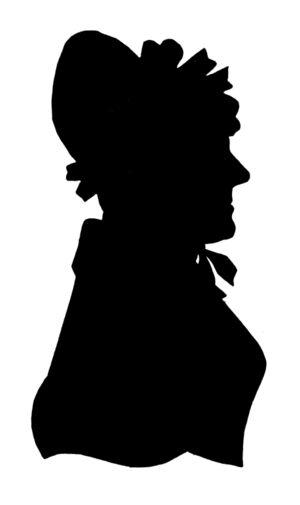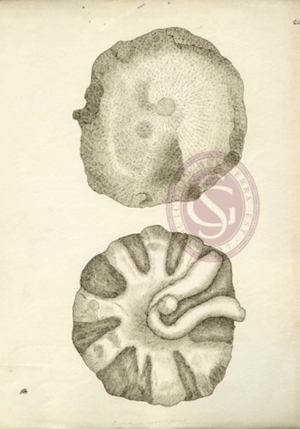Etheldred Benett facts for kids
Quick facts for kids
Etheldred Benett
|
|
|---|---|
 |
|
| Born | 22 July 1776 Tisbury, Wiltshire, England
|
| Died | 11 January 1845 (aged 68) Norton House, Norton Bavant
|
| Resting place | Bavant Parish Church |
| Occupation | |
Etheldred Anna Maria Benett (born July 22, 1776 – died January 11, 1845) was an early English geologist. Many people believe she was the first female geologist. She spent most of her life finding and studying fossils in South West England.
Etheldred worked with many important geologists of her time. Her fossil collection was one of the biggest back then. It helped a lot in making geology a real field of science.
Contents
Early life and home
Etheldred Anna Maria Benett was born in 1776. She came from a rich family in Wiltshire. Her father was Thomas Benett and her mother was Catherine Darell. Her great-grandfather was William Wake, who was an important church leader.
From 1802, Etheldred lived at Norton House in Norton Bavant, near Warminster, Wiltshire. She lived there with her sister, Anna Maria. We don't know much about Etheldred's daily home life, except for her amazing work in geology. There are no known paintings of her, but a simple outline drawing was published in a book about geology in 1911.
Amazing fossil collection
From at least 1809 until she died, Etheldred spent her time collecting and studying fossils. She started in the Warminster area of her home county. Etheldred knew a lot about stratigraphy, which is the study of rock layers. This helped her find fossils. Since her family was wealthy, she could even hire people to help her collect fossils. She could also buy fossils that were already cleaned and ready to study.
Her interest in geology grew thanks to her sister-in-law's half-brother, Aylmer Bourke Lambert. He was a botanist (someone who studies plants) and also loved collecting fossils. He was a member of important scientific groups like the Linnean Society and the Geological Society. Through him, Etheldred met many leading geologists of her time.
Because Etheldred was not married and had her own money, she could spend much of her life on geology. She focused on collecting and studying fossils, especially fossil sponges. Her collection was one of the largest and most varied of its time. Many scientists visited her home to see it. It had over 1500 specimens!
Etheldred was very good at finding fossils from the Cretaceous period in Wiltshire. Some of the fossils in her collection were the first ever drawn and described. Others were very rare or perfectly preserved.
She shared her findings with other fossil experts, including the Sowerby family. Forty-one of her fossils were included in a major fossil book called Mineral Conchology. She had the second-highest number of contributions to this important book.
Challenges for a woman in science
Once, after seeing part of her collection, Tsar Nicholas I thought Etheldred was a man. He then gave her an honorary degree from the University of St. Petersburg. This was amazing because women were not allowed to go to universities back then! The Geological Society of London also would not let her join because she was a woman. Etheldred herself noted that "scientific people, in general, have a very low opinion of the abilities of my sex."
After she died, her fossil collection was sold to a doctor named Thomas Wilson. He then gave the collection to the Academy of Natural Sciences of Philadelphia in the United States. Most of her fossils are still there today. A few are in British museums, like the Leeds City Museum.
Etheldred's collection had many important discoveries. She even gave modern names to some of them. For example, she called her fossil sponges "polypothecia" and her ammonites (ancient sea creatures) "drepanites." She also found rare fossil clams with their soft parts still preserved. These were the first of their kind ever found.
For a long time, people thought Etheldred Benett's entire collection was lost. But in 1989, the Philadelphia Academy became interested in early English fossil collections again. This led to her work being recognized once more. People started talking about her two publications and the names she gave to fossils. Many important pieces from her collection were photographed and studied.
Etheldred also loved collecting and describing shells. Many of the shells she found were new discoveries. She once wrote that her shell collecting left her no time to look at other fossils!
Recognition and impact
Etheldred's unusual first name, which sounds a bit like a man's name, often made people think she was male. For example, a scientific group in Moscow gave her membership as "Master Etheldredus Benett" in 1836. German geologists who wrote about her work also called her "Miss Benett."
Etheldred lived at a time when many things, including fossils, were explained by religion. Many people thought fossils were from big events like Noah's flood. Also, many well-known scientists were church leaders.
Being a woman was a challenge for Etheldred. Another challenge was that she lived in Wiltshire, far from London, which was the center of geology at the time. Illness and family problems also sometimes stopped her from working on geology as much as she wanted.
She met William Smith, who is known as the "father" of English geology. She gave him a fossil coral. He even mentioned her in his letters, writing about "ladies in Wiltshire" who were great at collecting fossils.
Her work was praised by important people. Gideon Mantell called her "A lady of great talent and indefatigable research." The Sowerby family said her "labours in the pursuit of geological information have been as useful as they have been incessant."
Etheldred Benett was chosen as the symbol for a conference in 2005 about "The role of women in the history of Geology." This shows how important her work is recognized today.
Contributions to geology
Etheldred Benett's work was very important for understanding the early geology of Wiltshire. She talked a lot with other geologists like George Bellas Greenough (the first president of the Geological Society of London), Gideon Mantell, and William Buckland. She freely shared her ideas and fossils from her collection with museums and other good causes. She even sent some to St. Petersburg. By trading many fossils with Mantell, they both gained a much better understanding of the rocks in Southern England from the Lower Cretaceous period.
Like many women scientists of her time, Etheldred mostly taught herself about geology. Because she had her own money, she was able to pay for a detailed drawing of the rock layers at the Chicksgrove Quarry near Tisbury, Wiltshire in 1819. This drawing became the first detailed map of the rock layers in that quarry. Even today, people still find plant and reptile fossils there.
In 1825, Etheldred made a painting of a meteorite that fell in Ireland in 1813. This painting is now in the archives of the Geological Society of London. In 1831, she wrote and published her own book called Catalogue of the Organic Remains of the County of Wiltshire. This book had many of her drawings of molluscs (like snails and clams) and sponges. This book showed that she was a true pioneer in studying fossils and rock layers.
Her book was printed in small numbers and not widely shared. It is thought that she might not have realized how valuable her work was.
Later life
During the last twenty years of her life, Etheldred was often ill. This meant she spent less time collecting fossils herself. Instead, she hired local collectors to find specimens for her. After 34 years of building one of the largest collections of Wiltshire fossils, Etheldred Benett died at her home, Norton House. She was 69 years old.
Works
- Catalogue of the Organic Remains of the County of Wiltshire (1831)
Images for kids
See also
 In Spanish: Etheldred Benett para niños
In Spanish: Etheldred Benett para niños





